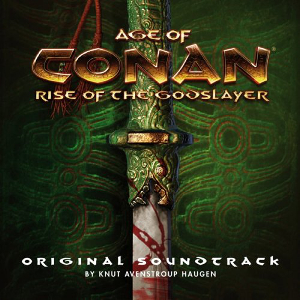Age of Conan -Rise of the Godslayer- Original Soundtrack
 |
Album Title: Age of Conan -Rise of the Godslayer- Original Soundtrack |
| Record Label: Grappa |
|
| Catalog No.: GRCD-4326 |
|
| Release Date: May 30, 2010 |
|
| Purchase: Buy at Official Site |
Overview
A MMORPG revival of the Conan franchise, Age of Conan has been well-received since its debut on Hyborian Adventures. Knut Avenstroup Haugen’s score offered an impeccable depiction of Conan’s lush yet savage universe. The expansion Rise of the Godslayer introduced a new Eastern setting and race, the Khitai. To match this setting, the composer hybridised features of his original score with traditional Chinese instruments. He released the score as a CD, complete with a bonus DVD featuring surround sound mixes. The soundtrack is also available digitally.
Body
While Age of Conan: Rise of the Godslayer maintains a focus on exotic and ancient sounds, this time around the central idea is different. The score is much more inspired by Asian instruments, with traditional Chinese instruments being featured throughout the soundtrack. The “Prologue: The Bitter Steppes of the West” captures the new setting of the expansion in a cinematic manner; it develops from lush cinematic orchestrations reminiscent of Hyborian Adventures into a more intimate sound highlighting Chinese instruments. The pentatonic melodies give a firm sense of place, while the solo flute is beautifully performed. It’s a great way to capture the new setting of the game. This influence continues throughout the soundtrack right up to the equally effective closer, “Epilogue: The Eternal Empire”.
The scenic tracks on Haugen’s score tend to keep things simple, but are generally very effective. For example, “Villages of Khitai” features little more than flute melodies above plucked strings. While sparse, it’s the perfect way to capture a peaceful country life. It’s the richness of the featured melodies that ensure it is still satisfying and Haugen certainly incorporates some Western influence. Meanwhile “Northern Grassland” introduces the most sacred place in the game with another intimate ensemble performance. The instruments describe everything from the ancient temples to the wolf-infested tropical outlands. “Silken Wind Through the Bamboo Forest” meanwhile has a more desolate and desperate tone. The soloists — especially the erhu, guzheng, and dizi players — are so expressive in each of these tracks.
There are also exciting action tracks to contrast with the scenic entries. “Warriors of the East” and “Battle of the Factions” are incredibly fast-paced and have a savage sound. The taiko ensemble is particularly effective on such tracks, giving a percussive driving force, while maintaining the Asian influence. Other tracks continue the bombastic orchestral style that Haugen developed on the Hyborian Adventures, notably “Hyrkanian Raiders Attack” and “All Heroes Unite!”. They’re excellently written and vibrantly performed, with the latter being a pinnacle of the score. The climax of the soundtrack is also darkened by suspenseful event tracks such as “Charge of the Corrupted” and “Horrors of the Jade Citadel”, both of which hybridise horror influences into the score. The only limitation is that several of these tracks are brief, due to restrictions imposed by their in-game usage.
Summary
To create a musical score for Age of Conan, Haugen turned to many different sources: For the music of the different ethnic groups, Haugen studied traditional music from relevant parts of the world. For the overall sound of the Hyborian Age, Haugen studied ancient and medieval music as well as the romantic orchestra repertoire and film score. His tremendous hard work is definitely reflected in the soundtrack to both the original and the expansion, which is nothing but fresh and enjoyable. The Asian instruments on Rise of the Godslayer are a particularly enjoyable addition to the universe’s sound. That said, it’s not necessary to appreciate Chinese or Conan music to truly appreciate the soundtrack — its melodic focus and emotional richness should make it highly accessible to all.
Do you agree with the review and score? Let us know in the comments below!
4
Posted on August 1, 2012 by Harris Iqbal. Last modified on January 18, 2016.














